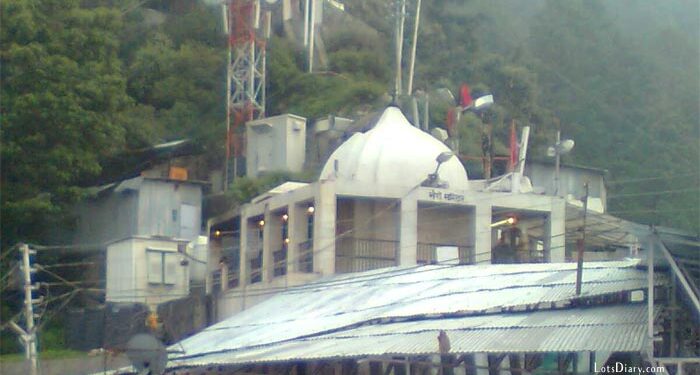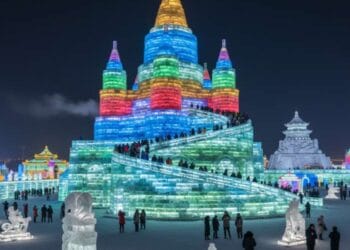Mata Vaishno Devi Temple is a religious site dedicated to the power of Mata Vaishno Devi under the Hindu tradition. This holy place of Mata Vaishno Devi is situated on the Trikuta mountain. The idol of Mata Vaishno Devi resides inside a natural cave, which is located in the Union Territory of Jammu and Kashmir, India. Mata Vaishno Devi is one of the most revered holy religious places in North India.
It is situated at a height of 5200 feet above sea level, approximately 12 kilometers away from Katra town. Every year, millions of pilgrims come to this holy place for darshan.
It is said that the security of this temple is provided by Lord Hanuman, an avatar of Lord Shiva, and along with Shri Hanuman, Baba Bhairav (another avatar of Lord Shiva) is also present to guard the temple.
There is a belief that whenever a pilgrim goes to Mata Vaishno Devi Temple, they must first visit Bhairav Baba. Only then do they begin the rest of their journey.

Tourist Attractions Near Mata Vaishno Devi Temple
Near Vaishno Devi Temple, there are many tourist spots and beautiful views of hill stations. Because Jammu is deeply connected with the beautiful valleys of the cold region.
In Jammu, tourist attractions include Amar Mahal, Bahu Fort, Mansar Lake, and Raghunath Temple.
About 112 kilometers from Jammu, Patnitop is a famous hill station where one can witness snowfall during winter. The snowfall in Patnitop displays a very scenic and enchanting view.
Near Katra, apart from temples like Shiv Khori, Jhajjar Kotli, Baba Dhansar, Mantalai, Kud, Batote, there are also many famous tourist spots.

Shri Bhairav Baba Temple

According to ancient beliefs, the area where the Bhairav Baba temple is built is the place where Mata Vaishno Devi killed Bhairav Baba. This place is called Bhavan. Near this location, there are also caves of Maha Kali, Maha Saraswati, and Maha Lakshmi goddesses. Their combined form is known as Mata Vaishno Devi.
As per ancient beliefs, after Mata Vaishno Devi killed Bhairav Baba, his head fell about 3 km away. The Bhairav Baba temple is built at that place. It is said that after his death, Bhairav Baba felt remorse and sought forgiveness from Mata Vaishno Devi.
According to belief, Mata Vaishno Devi forgave Bhairav Baba and gave him a boon, saying that any devotee who comes for her darshan will only be considered complete if they also visit Bhairav Baba.
Origin and Legends of Vaishno Devi (Kashmir)
According to Hindu mythology, the origin of Vaishno Devi is linked to the story of a young girl named Vaishnavi. It is said that she was an incarnation of the three forms of the goddess – Maha Kali, Maha Lakshmi, and Maha Saraswati.
The legend is as follows: Vaishnavi was born in South India to a devout Brahmin couple. As she grew up, she showed immense devotion to Lord Vishnu and decided to dedicate her life to meditation and penance. Eventually, she left her home and wandered in the forests, where she engaged in deep meditation.
One day, Lord Rama, the seventh avatar of Vishnu, appeared before her and blessed her. Vaishnavi expressed her desire to accept him as her husband, but Lord Rama told her that he had taken a vow of monogamy with his wife Sita.
Understanding this, Vaishnavi requested a boon to serve him in the surrounding area. Lord Rama granted her wish and blessed her with the power of immortality.
After Lord Rama’s departure, Vaishnavi continued her deep penance, and it is believed that Lord Vishnu himself came to test her devotion in the form of Lord Hanuman. Pleased with her unwavering devotion, Lord Vishnu granted her another boon. This time, she requested to take human birth to experience human emotions and attain salvation.
In her human form, Vaishnavi was born into a humble Brahmin family as Vaishno Devi. As she grew up, she remembered her past incarnation and the purpose of her birth. She left her home in search of spiritual knowledge and began her spiritual journey.
During her journey, Vaishno Devi faced many challenges and overcame them with her divine powers. Legend says that she finally reached the sacred cave of Trikuta mountain and transformed into a rock form to meditate for eternity.
It is believed that the sacred temple of Vaishno Devi is the place where the goddess resides in her rock form, and millions of devotees go on pilgrimage to receive her blessings and guidance. The legends and stories of Vaishno Devi have made this temple one of the most important and revered religious places in India.
Fame of Vaishno Devi (Kashmir)
The Vaishno Devi Temple in Kashmir is known as one of the most sacred and revered Hindu pilgrimage sites in India. Its fame mainly arises from the following aspects:
- Spiritual Importance: This temple is dedicated to Goddess Vaishno Devi, who is considered a form of divine feminine power. Devotees visit the temple seeking her blessings, protection, and fulfillment of their desires.
- Ancient Heritage: The temple has a history dating back to ancient times, making it a place of rich cultural and religious heritage. Its connection to Hindu mythology and legends adds to its attraction.
- Scenic Location: The temple is located on the picturesque Trikuta mountain surrounded by mesmerizing natural beauty. The climb to the temple enhances the sense of spiritual journey and adventure for pilgrims.
- Massive Pilgrimage: Vaishno Devi Temple attracts millions of devotees from all over India and abroad every year. It is one of the most visited religious sites, especially during auspicious occasions and festivals.
- Worshipped Deity: Goddess Vaishno Devi is worshipped with deep devotion and reverence, forming a strong emotional bond between the devotees and the temple.
- Cultural Significance: The pilgrimage to Vaishno Devi is not just a religious practice but also an integral part of the region’s culture and tradition. It has played a significant role in shaping the spiritual identity of the area.
- Accessibility: Despite being located in the mountains, the temple has become relatively accessible due to improved infrastructure and transportation, making travel easier for devotees.
- Positive Impact: The temple has a significant impact on the local economy, supporting various tourism and hospitality-related businesses and livelihoods in the region.
In summary, the fame of Vaishno Devi Temple is a combination of its spiritual significance, historical heritage, scenic location, and the unwavering faith of millions of devotees who visit the temple every year.
Food Options in Vaishno Devi (Kashmir)
In Vaishno Devi, you will find various food options to cater to the needs of pilgrims and visitors. Food options may include:
- Traditional Indian Meals: There are many small restaurants and food stalls offering traditional Indian meals like dal (lentils), rice, roti (Indian bread), sabzi (vegetable dishes), and various regional specialties.
- Snacks and Street Food: You can find various snacks and street food options like samosa, pakora, pani puri, chaat, and other quick bites.
- North Indian Dishes: Being in the northern region of India, you can enjoy North Indian meals such as chole bhature, rajma chawal, and different types of naan bread.
- Local Kashmiri Cuisine: Some eateries also serve local Kashmiri dishes, including Rogan Josh (a lamb dish), Dum Aloo (potato curry), and Yakhni (a yogurt-based meat stew).
- Beverages: For refreshments, tea, coffee, and soft drinks are available at many spots.
- Sweets and Desserts: Enjoy delicious Indian sweets like gulab jamun, jalebi, and kheer as delightful desserts.
It is important to note that due to the spiritual significance of the temple, most food establishments in Vaishno Devi cater to vegetarian preferences. Also, food options may vary depending on the season and the flow of pilgrims. As a popular pilgrimage site, Vaishno Devi ensures that visitors have a variety of food options during their stay.
Transport Facility to Reach Mata Vaishno Devi
A large city near the Vaishno Devi Temple is Jammu.
Jammu is connected to all major cities in India via rail, road, and air routes. One can reach Jammu by bus, taxi, train, or airplane.
After that, the mountain climb begins. For climbing, apart from walking, options like palanquins, mules, and electric vehicles are available to reach the temple. A helicopter service is also available.
The nearest railway station to the temple is Shri Mata Vaishno Devi Katra Railway










